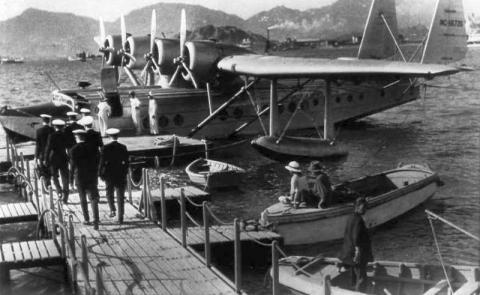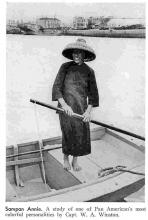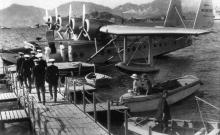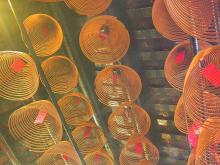CHIN YUN GI (aka Sampan Annie) [c.1884-????]
Primary tabs
Pelicanfilm writes:
Hong Kong was a critical juncture point for air connections - certainly for Pan Am, both before and after the war. It was a favorite stop for Pan Am crews and passengers alike. One of the legendary stories that have come down the years is that of "Sampan Annie," the woman whose abilities as a "waterman" in handling Pan Am's big flying boats as they were guided to the dock adjacent to the Kai Tak Aerodrome became famous.
He thinks she may be the woman in the bottom-right corner of this photo:
Any ther photos / information gratefully received.





Comments
Sampan Annie
SAMPAN ANNIE-Hong Kong
In Hong Kong, shipping has always been serviced by “sampan girls” particularly naval ships which often had their hulls repainted by teams of these women in exchange for left-over food and scraps. However, few are aware that at least one sampan girl also serviced flying boats.
This essay was published in the form of a letter to the editor of Pan American Airways in-house magazine ‘New Horizons’ edition dated September 1941. Written by W.B. (Shorty) Greenough-Pan American Airways Chief Mechanic-Hong Kong
-------------------------------------------------------------------------------------------------------------------------------
One little known fact about “Annie” is that her real name is ChinYun Gi. Better known, in Hong Kong at least, is her status as head of a family group which numbers at least 35 or 40. Family ties are sacred and family traditions are reverently observed in China, as is well known. In the case of Annie’s family, it is one of those floating groups which are so numerous at Chinese seaports and along Chinese rivers. Thousands of Chinese know no other home than the fishing boats on which they are born, live their lives, and die.
The Chin family has a veritable fleet, principal vessel of which is the eighty-foot junk which is the mother-ship and from which Sampan Annie directs the lives of her numerous brood. It has always been her custom when a son gets married to buy him a boat; thus, there are now four forty-foot sampans equipped for fishing. As each of the foregoing vessels is equipped with a small sampan in the order of a row boat, the fleet has nine units in all.
Annie’s immediate family consists of her husband, five sons and three daughters. The others are son’s wives and children. Some of Annie’s own children are about the same age as the grandchildren; she, herself, is about 65 years old. Fishing has been the family’s occupation and means of livelihood for many years; and, of course, it was Annie’s years of experience with the fishing boats which gave her the skill with sampans for which she is noted.
She got into the airline business when CNAC was operating amphibian airplanes in and out of Hong Kong. When CNAC changed over to land operation, Annie was threatened with involuntary separation from the airline business. But we needed a boat man. Annie was eminently qualified, so we quickly made a deal. She was to get Hong Kong $20 a month; and although this amounts only to about $5 in American money, it was entirely satisfactory to Annie since it was in line with the incomes of her associates.
When it developed that one of her sons had a flair for things mechanical, we put him to work as a mechanic’s helper. The only name I have ever known for the son is “Horseface”. Another son works for CNAC as a cleaner.
Annie’s invariable costume is a black suit comprising trousers and jumper of black coolie cloth, and a huge basket-like coolie hat. Aboard her sampan she is always barefooted, but when going ashore she may wear shoes of the type favoured by the coolies and which consist either of a piece of auto tire or a piece of board with a strap. The black costume is exactly like that worn by thousands of other Chinese women in sampans. It must be comfortable because it is so loosely fitted. In fact, it is my impression that those suits come in one size only, that being the largest that would ever likely be required.
When Annie first came to work for us, she brought her own sampan along. However, I decided that her own boat had too many protuberances and sharp corners; so, we had a new sampan constructed and padded it around the gun-whales as protection for the Clippers. It is operated by a sculling oar like the typical sampan, this oar being directed over the stern of the boat and moved from side by side like the tail of a ship. The skill with which Annie gets around a Clipper, passing a line to the officer in the bow, getting breast lines and tail lines into place and warping the Clipper up to the dock, is nothing short of amazing. In the early days of Sikorsky operations, Annie became skilful in the beaching operation, but to her disappointment the larger Martins and still larger Boeings have never been taken from the water at Hong Kong.
One of the stories about the amazing Annie, a story that gained a wide circulation in the American press about three years ago, was to the affect that Annie supervised the work of mooring a Clipper after its arrival on Saturday morning and then requested permission to leave early. This request was granted on condition that she would be back on the job bright and early the next morning for the Clipper’s departure. To everyone’s surprise Annie was late in arriving. Annie’s loyalty and dependability are such that tardiness for her was just unthinkable. Then it came out that the reason she had wanted Saturday afternoon off was to give birth to her latest offspring. I can vouch for that story because it was I who gave her permission to go, and Mrs Greenough later went over to see Annie in the junk.
Annie’s proudest possession is the PAA Flight Engineer’s button which was presented to her by Vic Wright. She always wears it, sometimes upside down, when she appears at the Hong Kong base in advance of an arrival accompanied by various children and grandchildren. After her work has been done, she exercises what has become her prerogative of collecting every bit of food that remains in the galley, and then stages an impromptu picnic for whatever members of the family that happen to be along. At home on her own junk, too, she is the family provider, not just for sons and daughters but for the whole clan. They all help with the fishing and other work of course, but she directs everything. She buys the rice, the pork, Macao cabbage and spinach. Fish caught by the family is a regular feature of the menus. All the food is cooked on the mother boat to which all member of the family come at mealtime.
Shortly after this tale was published in September 1941, war arrived in Hong Kong in December. Annie and her family melted into the fishing community and got on with their lives.
On 11 January 1970, Pan American Airways ground-breaking Boeing B747 Jumbo Jet arrived for the very first time in Hong Kong. The next morning the South China Morning Post published a photograph of its 48-year-old Captain William Saulsbury, veteran of 22,000 flying hours, accepting a scroll from the diminutive 86-year-old Sampan Annie.
re: Sampan Annie
Thanks IDJ, that's a good write-up. I also found a brief mention of her on page 70 of the Popular Aviation magazine for October, 1939:
[...]
Overnight at Wake, a moonlight cruise in the glass-bottomed boat around the marine gardens, then on to Guam, Manila, Macao and, on the sixth day out of San Francisco, we land at Hong Kong. First to greet us is famed Sampan Annie, who sculls alongside to take personal charge of the docking of our big clipper. She never says much but she works plenty. She fairly makes the water foam as she darts here and there.
Overnight at Hong Kong, then back to Manila. Thirty-six hours there and we hop off at 3a.m. for Guam so we will land in daylight. [...]
The whole article is interesting to read. It's written by Captain R H McGlohn, and describes his 6-day flight from San Francisico to Hong Kong in command of a Clipper seaplane. The article starts on page 16 of the magazine.
Thank you both David and IDJ
Thank you both David and IDJ for your follow-ups about this. Very helpful!!